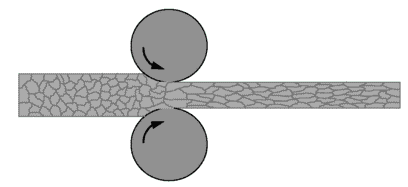What is Metal Cold Working?
Metal cold working is the process in which it is formed into desired shapes at room temperature. The metal is subjected to high pressures or impacts which increase its hardness and tensile strengths. Cold working of metals can be done by various methods including cold rolling, pressing, drawing and deep drawing, etc.

The process produces potential dislocations within the metal structure. This makes the metal stiffer. It is less ductile and less malleable, and once cold working is done, the metal is difficult to change its shape. The metal is said to become work hardened after cold working. To make it malleable and ductile again, the metal can be subjected to the annealing process.
Sheet Metal Cold Working
According to ASM Handbook of material selection and design thick plates, sheets and strips down to 1.6 mm (0.060 inch) can be prepared by hot rolling while cold rolling is capable of forming thinnest of all metal sheets steps from few micrometers to a fraction of the thousandth of an inch.
Sheet metal cold working can be used to produce controlled surface finish. The process consists of a set of two or more rollers spaced closed together, and the sheet or strip of metal is passed through them. The force exerted by rollers on the sheet reduces its thickness and increase the strength of the sheet.
During the cold rolling process, the rollers bow marginally which result in the sheets being a little thicker near the middle. The sheet metal tolerances are given in ASTM A568/A568M. For example for a 10 gauge sheet of steel, nominal diameter is 3.4163 mm (0.1345in), maximum diameter tolerance at the center is 3.568 mm (0.1405 in) and minimum at corners is 3.2639 mm (0.1285 in).
Sheet metal forming is typically done for carbon steel, alloy steel, stainless steel, copper, aluminum, and alloys of copper and aluminum.
Another method of producing sheet metal by metal cold working includes shearing and forming operation on the sheet carried out in a die and press system. The presses consist of beds of various sizes from 50cm x 30cm to 210cm x 140cm (20 in. x 12 in. to 82 in x 55 in.).
The pressing force ranges from 200 to 4500 kN (45-1000lbf). The speed of strokes varies from 100 strokes per minute to 15 strokes per minute for bigger sizes. The dies consist of four parts:
- Basic die set
- Punch
- Die plate
- Stripper plate
The die set is used to hold the punch, which shears the metal. The punch acts on the die plate, and stripper plate removes any scrap at the end of the cold working process. Other sheet metal cold working processes includes bending, curling, deep drawing, de-cambering, expanding, punching, rolling, spinning, stamping and wheeling, etc.
Sheet metal has many uses. Steel sheets are utilized in the manufacturing of automobiles, industrial equipment and for domestic purposes. Aluminum metal sheet is used in commercial aircraft manufacturing.
The metal cold working is selected for formability by following criteria:
- Resists surface damage and retain smooth surface.
- Achieve high strain levels without fracture and necking.
- Can withstand in-plane compressive and shear stresses without wrinkling and fracturing.
- Able to distribute the strains in the sheet uniformly.
For sheet metal working, the starting material is a flat rolled product such as hot/cold rolled sheet or a hot-rolled plate. Sheet metal is available normally in 15 standard gauges; the thickness ranges from 0.38 to 5.08mm.
There are several advantages of cold working apart from effect on ductility of metal such as:
- Superior mechanical properties such as strength and hardness due to strain hardening.
- Better surface finish of the product.
- High dimensional accuracy.
- Surface hardening heat treatment is not necessary if strain hardening is done on components such as cold rolled gears etc.
There are some disadvantages such as:
- The cold working machines require higher maintenance.
- Strain hardening makes the material less ductile.
- Cold working Effect on Ductility
Ductility of an object is defined as the ability to undergo sizeable plastic deformation without any fracture. According to ASTM A370, ductility is measured in percent permanent elongation after fracture in a 2in. Gauge length.
Conventionally this value is limited to 20-25% for cold rolling. During the cold working of metal, it is deformed plastically. The metal gets harder, the more it is deformed within its plastic region.
The process is also known as work hardening or strain hardening. Strain hardening is the vital part of the manufacturing process of stronger and rigid parts to be subjected to heavy loads. The strain hardening reduces the ductility and formability of metal.